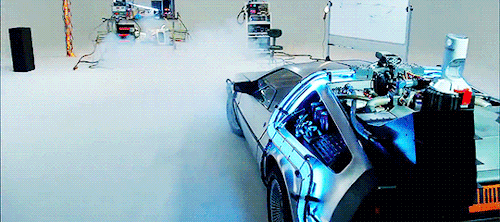How You Look At Color Is About To Get All Messed Up…
How you look at color is about to get all messed up…
A while back, I asked you to describe what color the moon appears to your eye. I got some pretty varied and entertaining answers, but you overwhelmingly agreed: The moon is essentially white or bright silver.
Well, you’re wrong.
The moon’s not white at all. It’s actually closer in color to an asphalt road, as we can clearly see in this 100% actually real series of images taken of the moon transiting Earth, courtesy of NOAA’s DSCOVR satellite:

That whole “the moon is white” thing? It’s just a nasty trick played on your brain by … well, another part of your brain. It has to do with the fact that our eyes perceive illumination in a scene relatively, not absolutely. It’s also why this GIF breaks your brain a little:

Watch this week’s It’s Okay To Be Smart video above to find out more!
Bonus: The PBS Digital Studios Science Squad™ brings you a double whammy of perceptual illusions this week! White isn’t the only light that messes with your visual system, not by a long shot. Did you know that red + green can look like… yellow?

Check out the video below from The Physics Girl and let Dianna teach you why, when it comes to colors, you should never quite believe your eyes:
More Posts from Inter-stellxr-blog and Others
Five Orion Technologies That Will Help Us Get Home From Mars
Orion is a key piece of NASA’s journey to Mars. The spacecraft, which was first tested in space last year, will enable crew to travel to deep space on the journey to the Red Planet and bring astronauts home safely. It’s a critical technology we’ll use to help NASA test, demonstrate and hone the skills and capabilities we need to operate farther and farther away from Earth.

Environmental Control and Life Support Systems
Water. Air. A temperate environment. A bathroom. These are some of the things astronauts need to survive the long journey back to Earth from Mars. NASA has developed an environmental control and life support system on the International Space Station and is designing such a system for Orion. The system can recycle carbon dioxide and make it back into useable air and process urine to make it into potable water, for example. Right now on the space station, engineers and astronauts are testing a filtering system for efficiency and reliability on long-duration missions. The investigation uses an amine-based chemical compound combined with the vacuum of space to filter and renew cabin air for breathing. When astronauts travel home from Mars, they won’t be able to count on the arrival of spare parts or extra supplies if something breaks or gets depleted, so engineers are hard at work developing reliable and robust technologies to keep crews alive and healthy in space.

Radiation protection
Astronauts traveling to and from Mars will be far away from the protective shield of Earth’s atmosphere and magnetic field, and their spacecraft and its systems will need to be able to protect against the full spectrum of space radiation. NASA is working now to develop protective methods.
Orion will use items already on board to protect the crew and create a temporary shelter in the aft bay of the spacecraft, which is the inside portion closest to the heat shield. This location minimizes the amount of equipment to move around while maximizing the amount of material that can be placed between the crew and the outside environment. The items that will be used include supplies, equipment and launch and re-entry seats as well as water and food. By using the items already on board, the astronauts benefit from additional shielding without adding to Orion’s mass.

Power and Propulsion
A spacecraft needs power and propulsion in space to refine its trajectory during the trip back to Earth. Orion will include a service module capable of helping the spacecraft make any necessary mid-course corrections. A service module provides power, heat rejection, in-space propulsion and water and air for crews, and NASA is working with ESA (European Space Agency) to provide Orion’s service module for its next mission in a partnership that will also bring international cooperation on the journey to Mars. The service module will provide propulsion, batteries and solar arrays to generate power and contain all the air, nitrogen and water for crews.
The ESA-provided element brings together new technology and lightweight materials while also taking advantage of spaceflight-proven hardware. For example, ESA is modeling several key components – like the solar arrays – from technology developed for its Automated Transfer Vehicle-series of cargo vessels, which delivered thousands of pounds of supplies to the space station during five missions between 2008 and 2015. NASA is providing ESA one of the Orbital Maneuvering System pods that allowed space shuttles to move in space to be upgraded and integrated into the service module.

Heat shield
When an uncrewed Orion was tested in space in 2014, the heat shield withstood temperatures of about 4,000 degrees Fahrenheit, or about twice as hot as molten lava. That heat was generated when the spacecraft, traveling at about 20,000 mph back toward our planet, made its way through Earth’s atmosphere, which acts as a braking mechanism to cause friction and slow down a returning spacecraft. Its speed was about 80 percent of what Orion will experience when it comes back from missions near the moon and will need to be even more robust for missions where return speeds, and therefore reentry temperatures, are higher.
Orion’s heat shield is built around a titanium skeleton and carbon fiber skin that provide structural support. A honeycomb structure fits over the skin with thousands of cells that are filled with a material called Avcoat. That layer is 1.6 inches at its thickest and erodes as Orion travels through Earth’s atmosphere.

Parachutes
A spacecraft bringing crews back to Earth after a long trip to Mars will need a parachute system to help it slow down from its high-speed reentry through the atmosphere to a relatively slow speed for splashdown in the ocean. While Earth’s atmosphere will initially slow Orion down from thousands of miles per hour to about 325 mph, its 11 parachutes will deploy in precise sequence to further slow the capsule’s descent. There are three forward bay cover parachutes that pull a protective cover off the top of the capsule, two drogue parachutes that deploy to stabilize the spacecraft, and three pilot parachutes that are used to pull out Orion’s three orange and white main parachutes that are charged with slowing the spacecraft to its final landing speed. The main parachutes are so big that the three of them together nearly cover an entire football field.
Engineers are currently building the Orion spacecraft that will launch on the world’s most powerful rocket, the Space Launch System, and will enable astronauts to travel farther into space than ever before on the journey to Mars.
Visit NASA on the Web for more information about Orion and NASA’s journey to Mars. http://www.nasa.gov/orion
Water found
This just in, NASA’s study published today reveals that they’ve found liquid water on Mars. It’s confirmed.

Construction Starts for Camera That Will Capture More Galaxies Than There Are People on Earth
Beginning in 2022, the most powerful digital camera ever built will start taking pictures of the southern sky. Over the course of a 10-year mission atop a mountain in Chile, the 3.2 gigapixel instrument is expected to accomplish a feat that might be hard to wrap your mind around. It will record tens of billions of galaxies floating in space–the first time a telescope will have ever identified more of the massive celestial objects than there are people on Earth.
Late last month, the U.S. Department of Energy gave its blessing for researchers to start building the camera that will sit at the heart of the Large Synoptic Survey Telescope (LSST). The gif above shows the three-ton, small-car-sized camera on the left. Illustrated is the system that slides filters down in front of the 3.2 gigapixel CCD, which senses light and is a digital camera’s version of film. The filters will let the camera record in light wavelengths from the near-ultraviolet to the near-infrared. Learn more and see images below.

Keep reading






Thanks, Doc

Wind farm star trails by Matt James

Meteorite Shower Over McCloud Falls, California
js






There’s been a rather startling decision today amongst the SETI (search for extraterrestrial intelligence) researchers.
Seth Shostak, senior astronomer at the SETI Institute, announced to his peers at a conference today that it’s time to begin what’s known as ‘active SETI’.
This is when we actively broadcast and effectively ‘alert’ potential neighbors to our presence.
Needless to say, this was a very polarizing conference.
People from Stephen Hawking all the way to science fiction writer David Brin have spoken out against broadcasting our presence into interstellar space.
They both have made comparisons to what happened when industrial civilizations first encountered indigenous peoples. Things never went well for the locals.
David Brin spoke at the conference and said, “The arrogance of shouting into the cosmos without any proper risk assessment defies belief. It is a course that would put our grandchildren at risk.”
I was initially sidelined by the idea. SETI Institute has never broadcasted into space in an attempt to make humanity’s presence obvious to alien observers. I hadn’t therefore really considered the topic much and shared the same worries as David Brin initially.
In my opinion though Dr. Shostak put an end to that worry:
“I don’t see why the aliens would have any incentive to do that.
Beyond that, we have been telling them willy-nilly that we are here for 70 years now. They are not very interesting messages but the early TV broadcasts, the early radio, the radar from the Second World War - all that has leaked off the Earth.
Any society that could come here and ruin our whole day by incinerating the planet already knows we are here.”
The point is if there’s a hostile and capable alien presence nearby, they would already know about us. The technology required to get to Earth even from the nearest star system is far more advanced than anything we can even dream up at the moment. Detecting our presence at that point is a cake walk.
Active SETI, would be a redundant risk as we’re clearly visible to those significantly advanced civilizations already (if there are any). That we’re here at all still suggests there are none.
To any nearby neighbors stuck on their home planets or solar systems, we are now going to be actively broadcasting messages.
The search is on.
Read more about today’s meeting at BBC World News.
(Image credit: ESO)
-
 tmitissy reblogged this · 8 months ago
tmitissy reblogged this · 8 months ago -
 tmitissy liked this · 9 months ago
tmitissy liked this · 9 months ago -
 iamyourchair liked this · 5 years ago
iamyourchair liked this · 5 years ago -
 ourorobotic reblogged this · 5 years ago
ourorobotic reblogged this · 5 years ago -
 johnsonsmithjones liked this · 6 years ago
johnsonsmithjones liked this · 6 years ago -
 crusadeofnothing liked this · 6 years ago
crusadeofnothing liked this · 6 years ago -
 happiestm reblogged this · 7 years ago
happiestm reblogged this · 7 years ago -
 happiestm liked this · 7 years ago
happiestm liked this · 7 years ago -
 firenashes reblogged this · 7 years ago
firenashes reblogged this · 7 years ago -
 jezzmokap liked this · 7 years ago
jezzmokap liked this · 7 years ago -
 diabeticdelight liked this · 7 years ago
diabeticdelight liked this · 7 years ago -
 blueinkblot reblogged this · 7 years ago
blueinkblot reblogged this · 7 years ago -
 holytragedyqueen reblogged this · 7 years ago
holytragedyqueen reblogged this · 7 years ago -
 holytragedyqueen liked this · 7 years ago
holytragedyqueen liked this · 7 years ago -
 earthsheartbeat liked this · 8 years ago
earthsheartbeat liked this · 8 years ago -
 the-shadow-83 reblogged this · 8 years ago
the-shadow-83 reblogged this · 8 years ago -
 the-shadow-83 liked this · 8 years ago
the-shadow-83 liked this · 8 years ago -
 9-man-run-in liked this · 8 years ago
9-man-run-in liked this · 8 years ago -
 allfn-blog liked this · 8 years ago
allfn-blog liked this · 8 years ago -
 jessiereads267 liked this · 8 years ago
jessiereads267 liked this · 8 years ago -
 littlestpersimmon liked this · 8 years ago
littlestpersimmon liked this · 8 years ago -
 rickwilcoxmagic-blog liked this · 8 years ago
rickwilcoxmagic-blog liked this · 8 years ago -
 joympt-blog liked this · 8 years ago
joympt-blog liked this · 8 years ago -
 lyndssssss-blog reblogged this · 8 years ago
lyndssssss-blog reblogged this · 8 years ago -
 nilandvoid liked this · 8 years ago
nilandvoid liked this · 8 years ago -
 elevatormirror liked this · 8 years ago
elevatormirror liked this · 8 years ago -
 fragmentare liked this · 8 years ago
fragmentare liked this · 8 years ago -
 arytha reblogged this · 8 years ago
arytha reblogged this · 8 years ago -
 periwinkle-life liked this · 8 years ago
periwinkle-life liked this · 8 years ago -
 dam-im-bad-at-this liked this · 8 years ago
dam-im-bad-at-this liked this · 8 years ago -
 othmeralia liked this · 9 years ago
othmeralia liked this · 9 years ago -
 engineering-girls reblogged this · 9 years ago
engineering-girls reblogged this · 9 years ago -
 companioncube76 reblogged this · 9 years ago
companioncube76 reblogged this · 9 years ago -
 komikbookgeek reblogged this · 9 years ago
komikbookgeek reblogged this · 9 years ago -
 uhgoodfm reblogged this · 9 years ago
uhgoodfm reblogged this · 9 years ago -
 tripnonspirituality111 reblogged this · 9 years ago
tripnonspirituality111 reblogged this · 9 years ago
"I don't know who will read this. I guess someone will find it eventually. Maybe in a hundred years or so." -Mark Watney
174 posts

